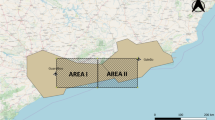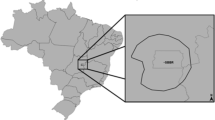Abstract
This work developed models, based on machine learning, for severe convective weather forecasts characterized by remotely sensed atmospheric discharge (AD) in the approaching landing region of airports in the vicinity of São Paulo. In the training and testing of machine learning algorithms, classical thermodynamic indices (input), derived from the atmospheric profiles of the Marte-São Paulo soundings, and ADs were used to characterize the convective severe weather (output), considering the period 2001–2017. The statistical distribution defined the locations, times, and severity of the convective events. The POD, 1-FAR, BIAS, kappa, and f-measure statistics were used to evaluate the 5-h prediction of convective event detection (and in parentheses for whether it is severe when the occurrence of lightning is greater than or equal to 1000), yielding values of 0.91 (0.85), 0.95 (0.94), 0.92 (0.89), 0.74 (0.77), and 0.88 (0.95), respectively. The results of applying the model to 30 days (hindcast), show that it is effective since it hit 96.7% of occurrence and 86.7% if they are severe. The detection errors of the model are presented and discussed.





Similar content being viewed by others
References
Almeida, V. A., França, G. B., & Velho, H. F. C. (2020). Short-range forecasting system for meteorological convective events in Rio de Janeiro using remote sensing of atmospheric discharges. International Journal of Remote Sensing, 42, 4372–4388. https://doi.org/10.1080/01431161.2020.1717669
Anquetin, S., Yates, E., Ducrocq, V., Samouillan, S., Chancibault, K., Davolio, S., Accadia, C., Casaioli, M., Mariani, S., Ficca, G., Gozzini, B., Pasi, F., Pasqui, M., Garcia, A., Martorell, M., Romero, R., & Chessa, P. (2005). The 8 and 9 September 2002 flash flood event in France: A model intercomparison. Natural Hazards and Earth System Sciences, 5(741–754), 2005.
Banta, R. (1990). The role of mountain flows in making clouds. Meteorological Monographs American Meteorological Society, 20, 1.
Barthlott, C., Corsmeier, U., Meißner, C., Braun, F., & Kottmeier, C. (2006). The influence of mesoscale circulation systems on triggering convective cells over complex terrain. Atmospheric Research, 81, 150–175.
Battan, L. J. (1953). Duration of convective radar cloud units. Bulletin of the American Meteorological Society, 34, 227–228.
Bhuiyan, M. A. E., Anagnostou, E. N., & Kirstetter, P. E. (2017). A nonparametric statistical technique for modeling overland TMI (2A12) rainfall retrieval error. IEEE Geoscience and Remote Sensing, 14, 1898–1902.
Bhuiyan, M. A., Nikolopoulos, E. I., & Anagnostou, E. N. (2019). Machine learning-based blending of satellite and reanalysis precipitation datasets: A multi-regional tropical complex terrain evaluation. Journal of Hydrometeorology. https://doi.org/10.1175/JHM-D-19-0073.1
DECEA (2019). Anuário estatístico de tráfego aéreo, p. 222. http://portal.cgna.decea.mil.br.
Doswell, C. I. (1987). The distinction between large-scale and mesoscale contributions to severe convection: A case study example. Weather Forecasting, 2, 3–16.
Ehsan, B. M. A., Begun, F., Ilham, S. J., & Khan, R. S. (2019). Advanced wind speed prediction using convective weather variables through machine learning application. Apllied Computing and Geoscineces. https://doi.org/10.1016/j.acags.2019.100002
França, G. B., de Almeida, M. V., & Rosette, A. C. (2016). An automated nowcasting model of significant instability events in the flight terminal area of Rio de Janeiro, Brazil. Atmospheric Measurement Techniques, 9, 2335–2344. https://doi.org/10.5194/amt-9-2335-2016
Freitas, J. H, França, G. B., & Menezes, W. F. (2019). Deep convection forecasting using decision tree in Rio de Janeiro Metropolitan Area, Anuário de Igeo, 42. https://doi.org/10.11137/2019_1_127_134.
Goodfellow, I., Bengio, Y., & Courville, A. (2016). Deep Learning (p. 785). MIT Press.
Guikema, S. D., Quiring, S. M., & Han, S. (2010). Prestorm estimation of hurricane damage to electric power distribution systems. Risk Analysis. https://doi.org/10.1111/j.1539-6924.2010.01510
Gultepe, I., Sharman, R., Dwilliams, P., Zhou, B., Ellrod, G., Minnis, P., Trier, S., Griffin, S., Yum, S. S., Gharabaghi, B., Feltz, W., Temimi, M., Pu, Z., Storer, L. N., Kneringer, P., Weston, M. J., Chuang, H., Thobois, L., Dimri, A., … Albuquerque Neto, F. L. (2019). A review of high impact weather for aviation meteorology. Pure and Applied Geophysics. https://doi.org/10.1007/s00024-019-02168-6
Holmes, G., Donkin, A. & Witten, I. H. (1994). "WEKA: A machine learning workbench. In Proceedings of ANZIIS '94—Australian New Zealnd Intelligent Information Systems Conference, pp. 357–361. https://doi.org/10.1109/ANZIIS.1994.396988.
Houze, R. A. (1993). Cloud dynamics, no 53 in international geophysics series. Academic Press.
Huntrieser, H., Schiesser, H., Schmid, W., & Waldvogl, A. (1997). Comparison of traditional and newly developed thunderstorm indices for Switzerland. Weather and Forecasting, 12, 108–125.
ICAO. Global Air Navigation Plan. 6ª ed. (2016). 142 f., International Civil Aviation Organization, Montreal, Canada.
Isaac, G. A., Bailey, M., Cober, S. G., Donaldson, N., Driedger, N., Glazer, et al. (2006) Airport Vicinity Icing and Snow Advisor (AVISA). 44th AIAA Aerospace Sciences Meeting and Exhibit. https://doi.org/10.2514/6.2006-1219.
Isaac, G. A., Bailey, M., Boudala, F., Burrows, W. R., Cober, S. G., Crawford, R. W., et al. (2012). The Canadian airport nowcasting system (CAN-Now). Meteorological Applications. https://doi.org/10.1002/met.1342
Isaac, G. A., Bailey, M., Boudala, F., Cober, S. G., Crawford, R., Donaldson, N., et al. (2011). Decision making regarding aircraft de-icing and in-flight icing using the Canadian airport nowcasting system (CAN-Now). SAE International. https://doi.org/10.4271/2011-38-0029
Isaac, G. A., Burrows, W. R., Cober, S. G., Crawford, R. W., Donaldson, N., Gultepe, I., Hansen, B., Heckman, I., Huang, L. X., Ling, A., Mailhot, J., Milbrandt, J. A., Reid, J., & Fournier, M. (2014). The Canadian airport nowcasting system (CANNow). Meteorological Applications, 21, 30–49.
Kane, R. J. (1991). Correlating lightning to severe local storms in the northeastern United States. Weather Forecasting, 6, 3–12.
Kunz, M. (2007). The skill of convective parameters and indices to predict isolated and severe thunderstorms. Natural Hazards Earth System, 7, 327–342.
Landis, J. R., & Koch, G. G. (1977). The measurement of observer agreement for categorical data. Biometrics, 33, 159–174.
Lee, R. R., & Passner, J. E. (1993). The development and verification of TIPS: An expert system to forecast thunderstorm occurrence. Weather and Forecasting, 8, 271–280.
Manzato, A. (2005). The use of sounding-derived indices for a neural network short-term thunderstorm forecast. Weather and Forecasting, 20, 896–917.
McCann, D. (1992). A neural network short-term forecast of significant thunderstorms. Weather Forecasting, 7, 525–534. https://doi.org/10.1175/1520-0434
Meißner, C., Kalthoff, N., & Michael, A. G. (2007). Initiation of shallow convection in the Black Forest Mountains. Atmospheric Research. https://doi.org/10.1016/j.atmosres.2007.03.003
Mueller, C., Saxen, T., Roberts, R., Wilson, J., Betancourt, T., Dettling, S., Oien, N., & Yee, J. (2003). NCAR auto-nowcast system. Weather and Forecasting, 18, 545–561.
Nascimento, E. D. L. (2005). Forecasting severe storms using convective parameters and mesoscale models: An adoptable operational strategy in Brazil. Brazilian Journal of Meteorology, 20(1), 121–140.
Paulucci, T. B., Gutemberg, B. F., Libonati, R., & Ramos, A. M. (2019). Long-term spatial–temporal characterization of cloud-to-ground lightning in the metropolitan region of Rio de Janeiro. Pure and Applied Geophysics, 176, 5161–5175. https://doi.org/10.1007/s00024-019-02216-1
Queiroz, A. P. (2009). Monitoring and immediate prediction of severe storms using radar data. Master's Dissertation of the Postgraduate Course in Meteorology. INPE.
Schulz, P. (1989). Relationships of several stability indices to convective weather events in northeast Colorado. Weather and Forecasting, 4, 73–80.
Soares, C. M., França, G. B., Almeida, M. V., & Almeida, V. A. (2021). Study of GOES-R thermodynamic indices for short-term forecasting of convective weather events using machine learning. Pure and Applied Geophysics, 178, 4651–4664. https://doi.org/10.1007/s00024-021-02889-7
Turman, B. N., & Tettelbach, R. J. (1980). Synoptic scale satellite lightning observations in conjunction with tornadoes. Monthly Weather Review, 108, 1878–1882.
Weisman, M. L., & Klemp, J. B. (1986). Characteristics of isolated convective storms. Mesoscale meteorology and forecasting. In P. S. Ray, Amer. Meteor. Soc, & S. D. Wilks (Eds.), Statistical Methods in the Atmospheric Sciences (2nd ed., pp. 331–358). Academic Press.
Williams, E. R., Weber, M. E., & Orville, R. E. (1989). The relationship between lightning type and convective state of thunderclouds. Journal of Geophysical Research, 94, 13213–13220.
Wilson, J. W. (1966). Movement and predictability of radar echoes. Tech. Memo ERTM-NSSL-28, National Severe Storms Laboratory, 30 pp. [Available from National Information Service, Operations Division, Springfield, VA 22161.]
Acknowledgements
This study is funded by the Department of Airspace Control (DECEA) via the Brazilian Organization for Scientific and Technological Development of Airspace Control (CTCEA) (GRANT: 002-2018/COPPETEC_CTCEA). Also, the authors are grateful to FURNAS Centrais Elétricas for providing the atmospheric discharge data.
Funding
This study is funded by the Department of Airspace Control (DECEA), through the Brazilian Organization for the Scientific and Technological Development of Airspace Control (CTCEA) (GRANT: 002-2018/Foundation for the Coordination of Projects, Research and Technological Studies (COPPETEC)_CTCEA).
Author information
Authors and Affiliations
Corresponding author
Ethics declarations
Conflict of interest
Not applicable.
Data Availability
Not applicable.
Code Availability
Not applicable.
Additional information
Publisher's Note
Springer Nature remains neutral with regard to jurisdictional claims in published maps and institutional affiliations.
Rights and permissions
About this article
Cite this article
de Castro, J.N., França, G.B., de Almeida, V.A. et al. Severe Convective Weather Forecast Using Machine Learning Models. Pure Appl. Geophys. 179, 2945–2955 (2022). https://doi.org/10.1007/s00024-022-03088-8
Received:
Revised:
Accepted:
Published:
Issue Date:
DOI: https://doi.org/10.1007/s00024-022-03088-8




